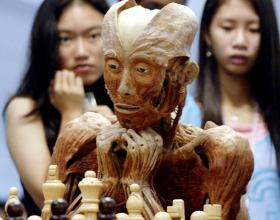New questions about the origins of the plastinated human specimens now touring the world
Excerpt from The Weekly Standard by Ethan Guttman
I have taken my first steps into “Body Worlds,” an exhibition at Vienna’s Museum of Natural History, and it has sparked a memory. The room where I am standing—dark, somber, strangely hushed—exhibits fetuses at various stages of development, placed on blocks that evoke a pagan circle of standing stones. The show’s mastermind, German doctor Gunther von Hagens, has suctioned all the liquid and fat from the small bodies and filled the soft tissues with hard plastic through his ingenious process of “plastination.” Usually, if you see a fetus in a museum, it is floating in a jar of liquid and is red or yellow and translucent. These bodies seem to be flat gray, and that is what ignites the flashback, a surreal freeze-frame of my son, born a month prematurely by C-section: As the medical staff pulled him out of my wife’s womb, just for a second, his flesh looked gray.
I’ve come to Vienna with a critical eye, to question whether some of the bodies displayed in the latest version of this traveling show (first created in 1995 but massively larger now) could include those of political and religious prisoners from China. Yet von Hagens is drawing me in. The stated purpose of his exhibitions is health education, and I am hearing a whisper of scientific justification: Is this not the mystery of life? Your curiosity is good. It absolves you. Go further. Step inside. I consent, and enter von Hagens’s freak show… Continue Reading Article on The Weekly Standard






